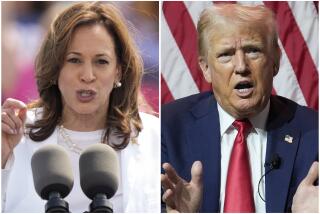Some Proposed Budget Cuts Are Illusions
WASHINGTON — President Clinton’s economic blueprint contains a purported $223 billion in federal budget cuts over the next four years, money that would be used to reduce the federal budget deficit and to help further his vision of an economically sound America.
But there is far less there than meets the eye.
While Clinton’s $169 billion in spending increases are real and likely to win relatively easy approval in Congress, some of his budget cuts are illusory at best.
Some of the changes that the Administration counts as cuts--like taxation of some Social Security benefits and the imposition of fees for a variety of government services--are actually feebly disguised tax increases.
And many of the proposed cuts are in politically sacred items--such as the Tennessee Valley Authority and farm subsidies--and are unlikely ever to be enacted.
Other large reductions come through projected savings from lower interest payments on the national debt--$24 billion. But that figure is based on optimistic projections of the effect of the entire budget package and may never materialize.
The bulk of the savings come from two programs--defense and payments to doctors and hospitals under Medicaid and Medicare, which are represented by powerful entrenched interests that are unlikely to yield without a fight.
“Listen,” said Leon E. Panetta, the director of the Office of Management and Budget. “Every one of these provisions has some kind of powerful backer on Capitol Hill. Who are we kidding?”
Panetta, sensing the battle ahead and the likelihood that the President’s package will be picked apart on the Hill, then issued a challenge to his former colleagues in Congress.
“If there are those that think it can be done differently, then let’s hear the specifics. Don’t give me balanced-budget amendments. Don’t give me some kind of gimmick. Talk to me about specifics and we’ll listen,” Panetta said. “But if you’re just going to give me your regular speech that you give at the Rotary Club, forget it.”
Of the $223 billion in cuts, $21.4 billion is actually an increase in taxes on moderate- and high-income Social Security recipients.
Another $11 billion in purported program cuts will actually be achieved through higher user fees on timber sales, agriculture programs, meat inspections, securities registration, harbors and waterways, grazing rights, irrigation water, parks and recreation sites, hard-rock mining, private aircraft landing rights and trademarks and patents.
Defense cuts total $88 billion over the four years, while reimbursements to doctors and hospitals under the Medicare and Medicaid programs will be trimmed by more than $38 billion.
That leaves something like $75 billion in cuts, for which Panetta and his aides scoured the $1.5-trillion federal budget looking for candidates. Clinton himself did the final carving, Panetta said.
Among the larger items is a one-year freeze on federal employee salaries and below-inflation federal pay increases from 1995 to 1997, for a savings of $8.3 billion. Included in the figure is elimination of “locality pay differentials”--meaning that FBI agents in high-cost cities like Los Angeles will now be paid the same as those exiled to dirt-cheap Casper, Wyo.
The Administration hopes to save another $8 billion by cutting the federal work force by 100,000 employees and yet another $8 billion by unspecified “administrative savings.” Government “streamlining” would also yield savings of $8 billion.
Although it’s a small item--$200 million--a 14% cut in federal funding for campus-based financial aid programs in 1994 seems to run contrary to Clinton’s other education goals. The aid programs provide supplemental grants, loan capital and money for work-study plans for college students.
The $1.2 billion left in the program will be frozen, instead of increasing gradually, over the next few years, so that by 1997, the projected savings will be $275 million, Education Department officials said.
Like all Americans, the Department of Housing and Urban Development is making a contribution as well, cutting $565 million in “special purpose grants.” These programs are described in internal government budget documents as “pork items” added by members of Congress.
* CAUTIOUS ASSESSMENT: Americans are concerned and uncertain as they ponder Clinton’s proposals: D1. Related coverage: A18-A20, D2.
More to Read
Get the L.A. Times Politics newsletter
Deeply reported insights into legislation, politics and policy from Sacramento, Washington and beyond. In your inbox three times per week.
You may occasionally receive promotional content from the Los Angeles Times.










